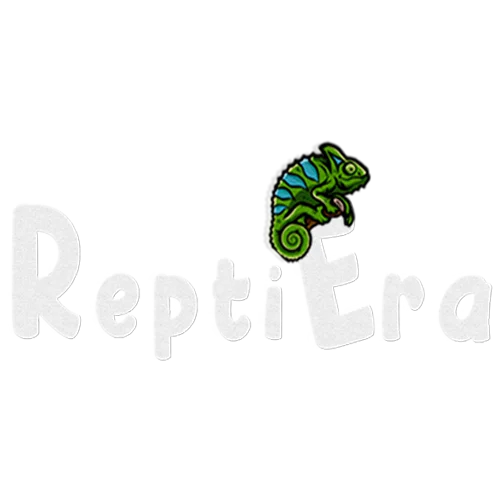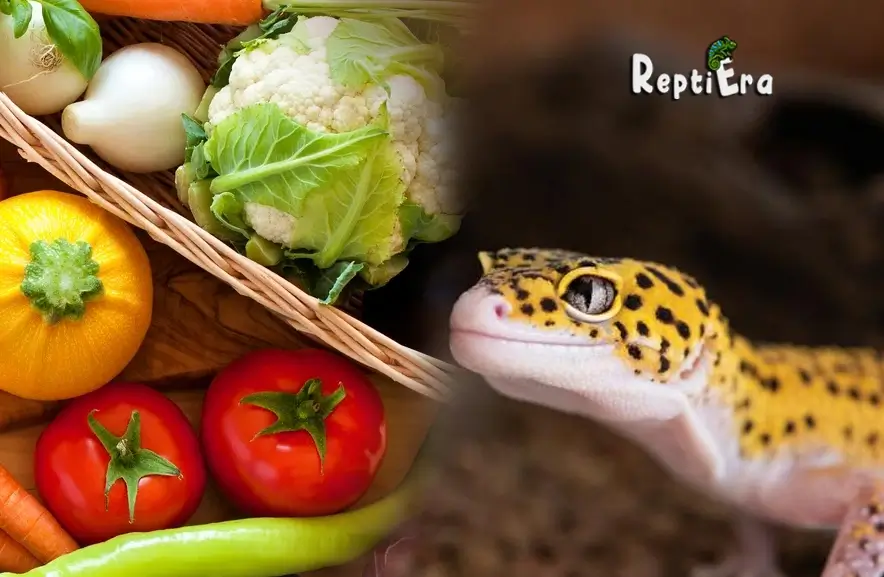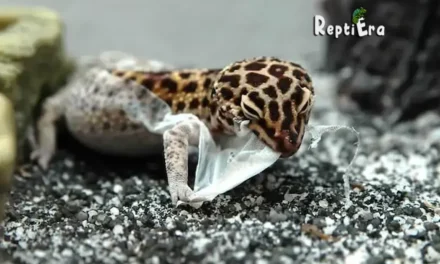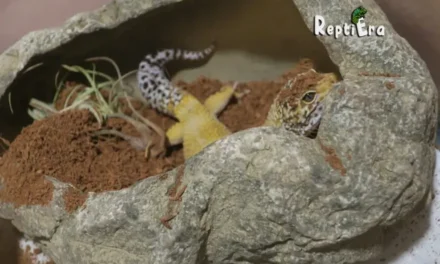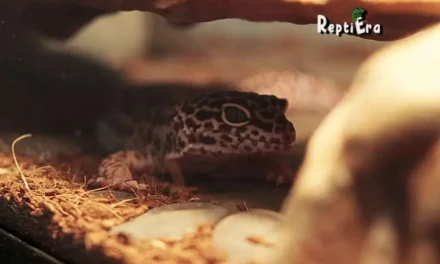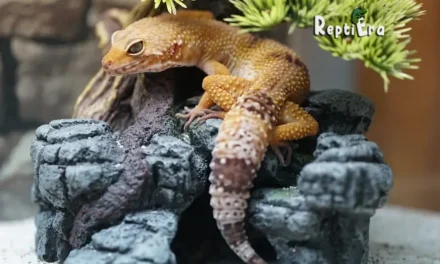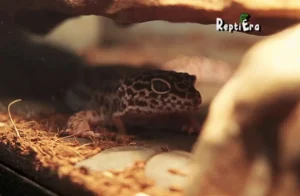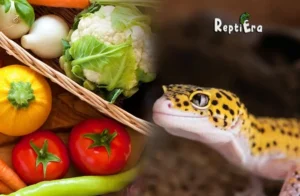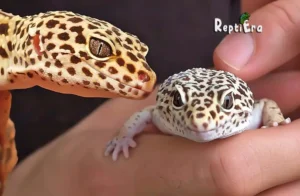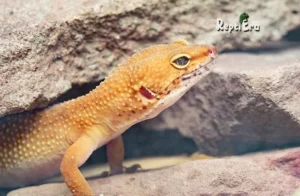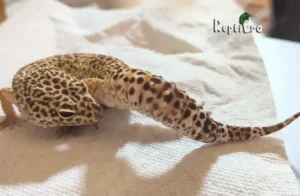In my experience with leopard geckos, it’s clear they cannot eat veggies. Vegetables are difficult for Leos to digest for several reasons.
Attempting to feed your gecko vegetables might lead to indigestion and other bad stomach symptoms. Instead of giving your lizard vegetables, it’s advisable to focus on providing nutrient-dense foods like bugs, which are better suited to their dietary needs.
This topic about whether leopard geckos can eat vegetables is often confusing, but allow me to explain: their digestive system simply isn’t equipped to handle plant-based foods.
Table of Contents
Can Leopard Geckos Eat Veggies?
Leopard geckos, originating from dry, arid, and rocky climates in Asia, are natural desert dwellers. Adapted to hot days and harsh cold nights, these reptiles have a natural history of thriving in environments where vegetables are not available.
In the wild, they are not found consuming vegetables from the dirt but are adapted to an ideal diet of insects and bugs, making them can’t eat or digest vegetables effectively. Instead, in captivity, maintaining this diet is crucial.
Trying to feed them vegetables is something they shouldn’t and typically won’t try, as it’s not a food source they are naturally inclined to. Countries in Asia, their native habitat, don’t often have fresh vegetables growing naturally, reinforcing their adapted dietary needs.
Vegetables That Aren’t Safe For Leopard Geckos
In the realm of leopard gecko care, it’s essential to understand that vegetables aren’t safe to feed them. These reptiles aren’t likely to try to eat vegetables, even when hungry, and offering them as a supplement to their main course is not a good idea for their stomachs.
Potatoes, tomatoes, onions, carrots, bell peppers, broccoli, cucumbers, lettuce, and celery are all examples of vegetables you shouldn’t offer to your leopard gecko. Interestingly, there is one situation where you need to keep fresh vegetables—not for your pet lizard itself, but for its food instead. Surprisingly, these veggies are used to gut-load the insects that become a nutritious meal for your gecko.
The only reason you’ll need to buy fresh veggies
When it comes to your pet gecko, there’s only one scenario where fresh veggies play a crucial role. This involves the process of gut-loading, a technique where you feed the bugs that your gecko will eventually eat. Gut-loading is essential for providing nutritious meals to your gecko, as the insects you purchase from a pet store may not always be fed high-quality foods.
Sadly, some are even fed wood or paper shavings. To effectively gut-load, you’ll want to feed these bugs with a commercially available insect diet and supplement this with fresh vegetables like carrots, sweet potatoes, and leafy greens for about 24 hours before offering them to your gecko. These additions are great to add to the bug food, enhancing the overall nutritional value of your gecko’s diet.
Reasons Why Leopard Geckos Can’t Eat Vegetables
From what we know, leopard geckos don’t eat vegetables as part of their wild diet, and there are several reasons why this won’t work out in captivity either. The primary reason is their anatomy; specifically, the structure of the leopard gecko’s digestive tracts.
These reptiles have evolved to process a diet consisting mainly of insects and not plant matter. To go into more detail, their digestive system is not designed to break down the fibrous nature of vegetables, which significantly affects their ability to extract nutrients from such foods. Therefore, incorporating vegetables into their diet does not align with their natural eating habits and physiological needs.
Reason 1: Leopard Geckos’ Teeth Can’t Grind Down Vegetables
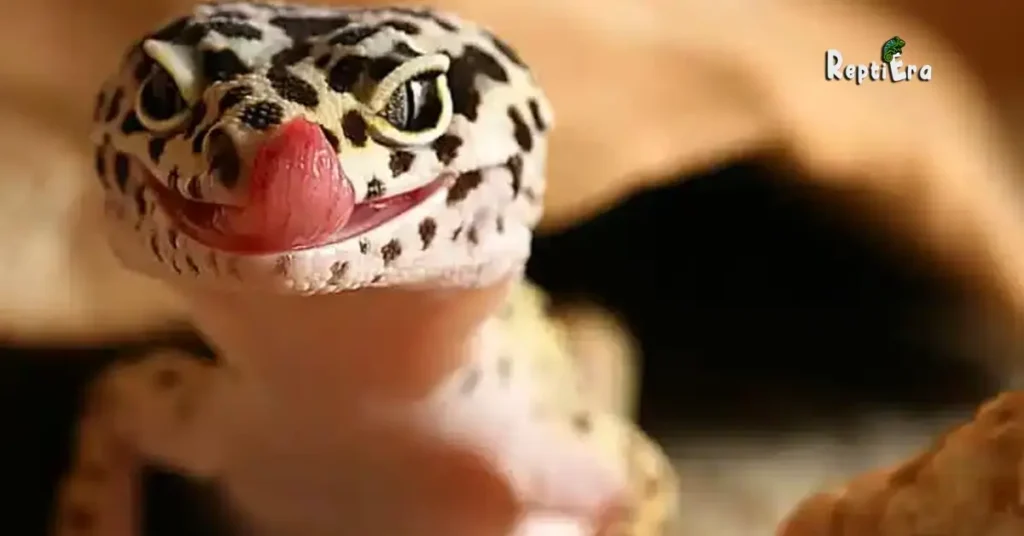
Herbivores, with their flattened teeth that are specialized to grind plant matter, are perfectly adapted for physical grinding, a critical aspect of digesting vegetation. In contrast, reptiles like leopard geckos don’t have grinding teeth for eating such vegetation. They lack the ability to swallow rocks or gastroliths, which in other animals aid in physically breaking down food in the gut.
Omnivores, which consume both meat and plant-based food, have a mix of flattened and pointy teeth, with the latter designed for gripping and tearing meat.
Carnivores, and this includes Leopard Geckos, are different. They have pointy teeth suited for slicing their insect prey. Their dental structure is utterly useless for the purpose of grinding down vegetables. Leopard geckos neither swallow gastroliths nor have a gizzard to store such elements safely, making it impossible for them to process plant matter effectively.
In essence, their physical attributes dictate their dietary needs, steering them away from plant-based foods, including vegetables, in a very definitive way
Reason 2: Leopard Geckos’ Guts Can’t Break Down Vegetables
Herbivores, with their huge guts capable of storing large amounts of vegetation, have specialized sections in their gastrointestinal tract. These organs, like the cecum or special stomachs split into chambers, efficiently break down plant matter.
This process is a complex one, often involving a synergistic relationship with microorganisms in their digestive system. These microorganisms produce an enzyme, cellulase, which breaks down cellulose, the main component of plant fibre. However, Leopard Geckos’ digestive systems lack these features, rendering them unable to extract nutrients from vegetables.
Unlike herbivores, Leopard Geckos and other carnivores have short guts that don’t hold a lot of food. This allows them to digest their food quickly and hunt more efficiently. Their stomachs are more like simple sacks, where their prey is exposed to hydrochloric acid and pepsin, enzymes crucial for breaking protein bonds found in meat.
Meat’s high protein content is important for these predators. The food then moves through the bowel, the lower section of the digestive tract, from the stomach to the anus. In Leopard Geckos, this part is small and can be easily blocked by undigested plant material.
Reason 3: Leopard Gecko Bowel Impaction
As a result of their unique physiology, if Leopard Geckos consume vegetables, it can cause bowel impaction. Their digestive system is not designed to break down the cellulose structure found in plants. Unlike herbivores, whose gastrointestinal tract can process cellulose with the aid of cellulase, geckos lack this capability.
In geckos, vegetation moves through the gastrointestinal tract faster than in herbivores, and by the time it reaches the bowel, it’s often still undigested material. This can block the bowel, leading to serious health issues like constipation, appetite loss, bloating, and lethargy. If left untreated, such impaction can even be fatal. Leopard geckos are not equipped with teeth or gastroliths for grinding down plant matter, making vegetables an inappropriate and potentially dangerous choice for their diet.
Reason 4: They Have Short Intestines
A significant problem in the anatomy of the leopard gecko that prevents them from eating vegetables is their relatively short intestines. This trait makes them efficient at digesting animal proteins but not plant-based materials. Digestion is a key process, where enzymes and gastric juices break down food and aid in nutrient absorption. Their smaller, energy-efficient overall structure is suited for their natural diet but not for digesting hard-to-break-down materials like plants.
In contrast, humans, for example, have pretty long intestinal tracts and are able to eat a variety of foods without issues. This difference highlights why leopard geckos aren’t cut out for breaking down veggies, as their bodies simply aren’t designed to handle such foods.
Reason 5: Their Digestive Tract Is Too Alkaline
The last reason why leopard geckos can’t eat veggies is due to the alkalinity of their digestive tracts. You might have heard about the benefits of Alkaline water, a trendy drink among the health-conscious who consume it for its high pH value. On the pH scale, anything above 7 is considered alkaline, while values below 7 are acidic.
An alkaline digestive system is great for the digestion of certain foods that break down easily, but not for others. The alkaline stomachs of leopard geckos pose problems when fruit and veggies are added to the mix. These foods make it harder for their stomach and other organs to break down, leading to an increased production of acid and bile. This can cause their system to become acidic, leading to short-term pain and potentially even lasting problems like acid reflux or stomach ulcers.
In terms of anatomical reasons, these factors significantly influence the feeding habits of your Leo. So, when we talk about feeding leopard geckos, it’s crucial to align their diet with their physiological capabilities, avoiding foods that their bodies are not designed to process efficiently.
What Do Leopard Geckos Eat?
While many pet reptiles like snakes—including ball pythons, California kingsnakes, and rosy boas—are true carnivores that rely heavily on animal proteins, Leopard geckos are a bit different. They are strict insectivores, meaning their meal plan for their entire lives consists solely of bugs. These bugs should never be caught in the wild, as they might host parties of toxic substances harmful to your lizard. Instead, it’s safer to buy their food from a reliable pet supply store. Typically, leopard geckos are fed mealworms, roaches, and crickets. The size of these insects should not exceed the width of your gecko’s head, a guideline that helps determine the appropriate length of the feed.
When it comes to feeding, a rule of thumb is to provide about 2 bugs for every inch of your gecko’s body. For instance, a 4-inch-long gecko would likely be eating around 8 bugs per meal. This might sound confusing, but a chart can help make things more clear. The frequency of feeding varies, usually being once a day or every other day, depending on the age and size of your gecko.
.
What Happens If A Leopard Gecko Eats Vegetables?
If you’re considering feeding your gecko vegetables, beware of the potential short-term and long-term side effects it could have on your pet gecko. Issues with the digestive tract are the first things you’ll notice if you offer veggies. Stomach cramping, indigestion, and bloating are common symptoms that leopard geckos may experience.
Additionally, consuming vegetables can cause diarrhea or constipation in these reptiles. While these issues aren’t typically serious or life-threatening, they certainly are not comfortable and could significantly put your pet’s well-being at risk.
Another problem area arises in their mouth. Given the raw and crunchy nature of vegetables, your geckos might suffer tears on the roof of their mouths, which could fester and cause pain whenever they chew. Over time, sores might develop, and their teeth could even get damaged from the tough chewing required for these unsuitable foods.
Leopard Geckos Get Nutrients From Vegetables Via Gut-loaded Insects
When it comes to Leopard Geckos, their dietary needs are quite unique, and understanding the best way to provide a nutritious diet is crucial. These geckos cannot directly benefit from vegetables as humans do; instead, they extract essential vitamins, minerals, and dietary fiber indirectly. The process of gut-loading plays a pivotal role here.
Essentially, gut-loading involves feeding the insects that are to be fed to the gecko. These insects, such as mealworms, crickets, and grasshoppers, are fed a variety of vegetation like raw potatoes, carrots, apples, and kale. This has to be done within 48 hours before the insect eats by the gecko to ensure the nutrients are still in the insect’s gut and can be transferred to the gecko’s tissues.
A personal experience that highlights the importance of this method is when I started using commercially-made gut-loading powder, specifically Calcium Plus Food for Crickets. This product is designed to maximize the vitamin intake and maintain a healthy balance in the calcium and phosphorus ratio.
Another aspect to consider is keeping the insects hydrated without the risk of them drowning. Products like bug gel or Fluker’s Cricket Quencher are excellent for this purpose as they provide moisture without the drowning risk. Remember, the staple feeder insects like mealworms, crickets, and grasshoppers are crucial, but how they are prepared before feeding your Leopard Gecko is equally important. By using these methods, Leopard Geckos can safely and effectively derive their nutritional needs from vegetables, albeit indirectly through their prey.
Leopard Geckos Should Never Be Given A Vegetable Mash
Despite what some internet mentions may suggest, Leopard Geckos should never be fed a vegetable mash. This is a lesson I learned the hard way. When one of my geckos became malnourished and poorly, I initially thought a vegetable mash might help it recover. In a sense, I was trying to apply human dietary logic to a reptile, which doesn’t work. I reached out to a specialist vet for clarification and was advised not to feed such a mash.
Instead, the vet prescribed a hydrolyzed protein mix which contains soya and is broken down through a chemical reaction with water. This process makes the plant matter high in protein and more bioavailable for the gecko’s body. The bioavailability of these building blocks is important for a living creature like a gecko, which needs nutrients that are prepared in a way that’s accessible and can be utilized quickly.
Hydration is a key component in preventing many reptile illnesses, and this protein mix not only delivers hydration alongside nutrients but is also more palatable. It tastes more delicious to a gecko, encouraging even an unwell one that want to eat. While it’s not a complete diet and should only be used in the short term, it’s a safer alternative to plant-matter-based diets. If your Leopard Gecko is unwell, always seek veterinary advice before making dietary changes.
Why Are Leopard Geckos Sometimes Seen Eating Vegetables?
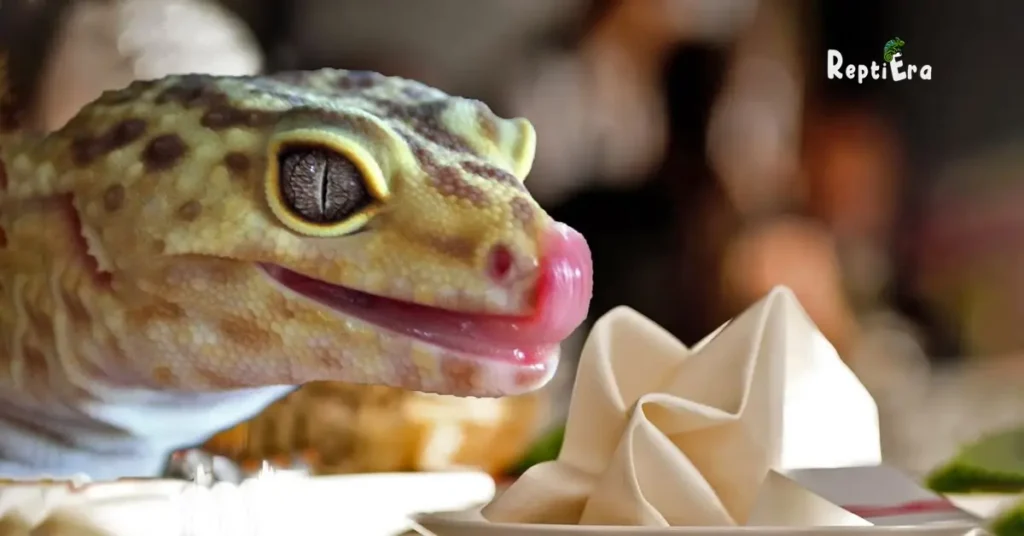
Sometimes, in captivity, you might observe Leopard Geckos attempting to eat vegetables if they are offered to them. This behaviour can be simply because the vegetables are there. Eating can be an enjoyable activity for these creatures, and when new foods are tried, the animal discovers whether it’s suitable or not, much like how children might taste mud or dogs might chew on Legos.
The geckos might be tempted by the movement of the vegetables, triggered by their instinct to attack anything that moves, although it’s unlikely they would naturally eat vegetables in the wild.
Another explanation is that Leopard Geckos, being obligate carnivores similar to cats, might eat unusual items like vegetables in an attempt to address some internal discomfort. Cats are seen eating grass occasionally, and theories suggest they do this purposefully to upset their stomach and trigger regurgitation or to help sweep their gastrointestinal tract for large defecation. Ongoing research into reptiles explores the possibility they might use vegetables in the same way these carnivores do.
Fruit Is Even Worse Than Vegetables
Fruit, another form of vegetation, should not be fed to Leopard Geckos for the reasons discussed above and is actually worse than vegetables. Fruits tend to be more acidic and high in sugar, which can potentially damage their teeth. While the topic of more reasons why fruits are harmful to Leopard Geckos will be expanded in a feature article, it’s crucial to understand that their digestive system is not designed to handle the natural sugars and acids found in most fruits.
What Can Geckos Snack On Instead?
When considering snacks for your gecko, it’s essential to focus on their care and dietary preferences. Most leopard geckos love to eat bugs, which they view not just as breakfast, lunch, or dinner, but as tasty treats. To figure out the kind of bugs your gecko prefers, try offering two different types and observe which one your pet goes for first.
After a couple of times, you’ll likely identify their favourite snack. These treats can be used to reward good behaviour or teach them to be comfortably held and handled. Plus, there are times when you might be feeling extra loving and wish to give something special. Special bugs like wax worms, although not the most nutritious meals, will get your pet’s mouth-watering and show them some extra care and affection.
What should a Leopard Gecko drink?
For a Leopard Gecko, drink options are straightforward: they require clean, fresh water to be available in their tank at all times. This can be provided using a dish that is sufficiently shallow to easily access the water without any chance of drowning. The dish should be stable enough so that the gecko can climb in and out without tipping it over. Also, it’s important to place the water dish in a spot where substrate from the cage won’t fall in, keeping it dry and stable to avoid any spillage.
FAQs
Do Leopard Geckos eat their own skin?
Yes, after shedding, Leopard Geckos often eat their shed skin for two reasons: no one exactly knows why they do it, but theories suggest it’s to avoid leaving traces for predators in the wild and because the skin contains protein and vitamins that are helpful for their growth, which they cannot get in another way.
Do Leopard Geckos eat their own eggs?
Sometimes, yes, female Leopard Geckos that lay infertile eggs, which are not created from contact with a male, may eat them. Opinions are split on why they do this; some say they might feel threatened or have a lack of calcium, but others assert they would not do this under any circumstances.
Do Leopard Geckos eat their own poop?
The general opinion is that Leopard Geckos do not eat their poop; however, they may sometimes try to bury it. It’s important for owners to make sure they check their Leo’s tank carefully for cleanliness and hygiene.
Can a leopard gecko eat lettuce?
Leopard geckos are insectivores and need to eat insects for proper nutrition, so they not only most likely won’t find lettuce appealing to their taste, but they also can’t digest it efficiently like greens or other vegetables.
Can leopard geckos eat boiled eggs?
For a leopard gecko’s diet, it’s safest to stick to the rule of food they would normally eat in nature; therefore, don’t feed your pet in captivity items like scrambled or boiled eggs, which they would most likely not encounter in the wild.
Can leopard geckos eat bread?
The fact of the matter is that leopard geckos cannot eat human foods; they are insectivores, meaning they should eat nothing but insects and drink water. The result is that your Leo could end up sick if it eats anything other than what’s appropriate for its diet.
Can leopard geckos eat any meat?
Leopard geckos are insectivores, meaning they should only eat bugs, as their bodies aren’t designed to digest fruits, vegetables, or any other kind of meat. Just insects provide the necessary nutrition because a variety of feeders cater to their dietary needs.
Conclusion
Vegetables are not an appropriate snack for leopard geckos. These tiny lizards are not built to digest them properly. In the wild, their diet does not include vegetables, and in captivity, attempting to eat them can cause both short and long-term effects that are detrimental to their health. Leopard geckos need a diet rich in bugs to live a long, healthy life. If you feel your gecko is lacking excitement or stimulation in its diet, consider buying new varieties of insects from a pet store. This not only provides them with the essential nutrients they need but also introduces some variety into their diet, catering to their natural hunting instincts.
